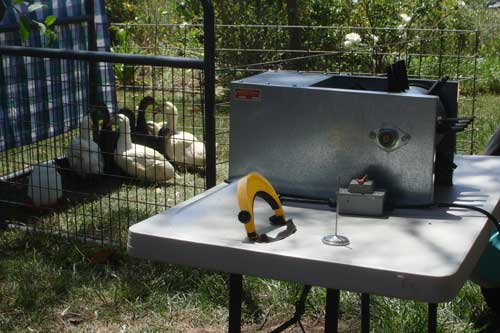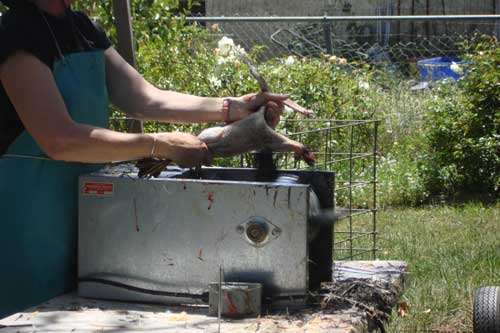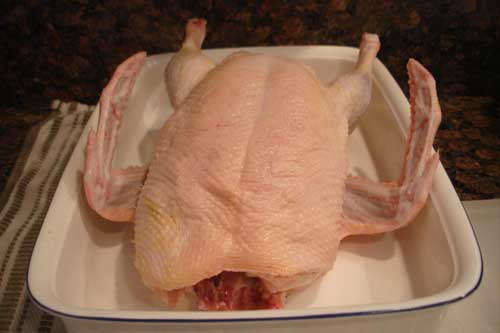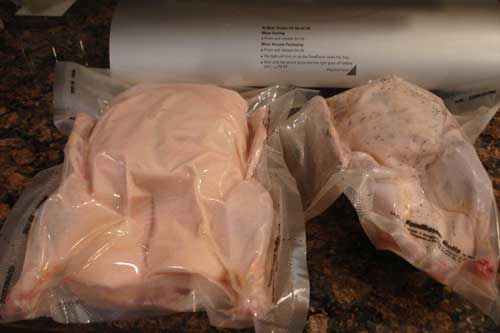The Duck Diaries
Butchering Day

BLOG POST WARNING!!!!! This post will chronicle the process of butchering our batch of meat ducks. If you are opposed to raising livestock for consumption this is NOT the post for you. It will be detailed and sometimes graphic. And—there will be pictures. Fair warning, folks, enter at you own risk.
Today day started early. Actually, the butchering day prep started yesterday. Brianne washed and sterilized two large ice chests cleaned the area where the butchering would take place, used almost every plastic container we own to make ice and generally readied our farm to put home raised meat in the freezer. She did all this while I worked more than a full day at my job. Sometimes our farm life and work life collide in unexpected ways and life gets crazy busy.
The morning was all about processing meat into meals, though. The ducks were pulled off feed the night before, but kept their water fonts so they don’t become dehydrated. Pots of water were boiling on the stove to give the scalder a head start at heating up. There were lined trash cans strategically placed near the killing and cleaning areas. Sandy will be here in about an hour with killing cones, scalder, and plucker in hand.
We have set up our makeshift butchering area near the patio where there is easy access to water and power. We will work in assembly line fashion—from killing to scalding to plucking to gutting to cooling. The set-up means we can work quickly and efficiently to get each duck processed and in the cooler as quickly as possible. I have knives, scissors, cutting board and plastic tablecloth at the ready. They will be the last supplies to be set out before we start.
Sandy and I have butchered chickens many times before, but never at my home. I’ve always packed up and brought the animals to her farm. So, today should be interesting, but we are as ready as can be and my set up doesn’t look much different than the arrangement we have at Sandy’s place.
Now I just wait for Sandy to arrive.
Once Sandy arrived we unloaded her equipment and set up the area. It was arranged to be close and efficient; not too much walking back and forth. The longest part of set up is getting the scalding water to the right temperature. It takes a hotter scald to pluck ducks than it does for chickens. When we butcher at Sandy’s house she starts the scalder early in the morning so it has hours to reach the right temp, but a traveling butcher needs a faster solution. Ours didn’t turn out to be a smart choice. I used the hot water from the water heater, which helped speed up the scalder, but when I tried to turn the faucet off it wouldn’t turn off all the way, so water was streaming through the garage. What a mess, but we couldn’t stop. We had a job to do and nothing could stand in the way. Our solution…hook up a hose to the water heater and use it to rinse the carcasses. After that we would deal with the problem.
After about 30 minutes of set-up we finally started. Sandy would hang a duck in the cone, slit its throat and let it bleed out. Afterward it was scalded and plucked. As I gutted it, separated the organs into what could be used and what went into the compost, and cleaned it up further and iced it down Sandy would move on to another duck. We laughed as the fatty ducks make processing them seem like diapering a baby covered in grease. The process went smooth though. After a few ducks we hit our stride. It was rhythmic.

With each new duck that passed over my table I thought more about being grateful than the actual process. I thought about how many people, some I know, but most I don’t, who can’t even cook a meal from scratch let alone raise their own food and process it into something edible. I thought about how this little farm has become an engine that feeds a family. I am grateful for the ability to raise my own food.
In a little over an hour we had processed all 6 of the Peking ducks. They were about 5 pounds each when dressed. The breast was plump and well covered with fat; the wings small and the legs dark. They looked like a large roasting chicken. Sandy, who has raised ducks before, said they looked great, just the way they should. The feathers don’t come off as easily as a chicken which means a little more cleaning after they are iced over night.
The Rouen’s however were a different story. They are a smaller breed, barely 3 pounds at processing. They are not as fat as the Peking and when they are plucked small bits of their dark feathers stayed under the skin which makes them look speckled and not cleaned properly. Their feathers are finer than the Peking and there is a lot more cleaning before they can be packed for freezing. I never did get them cleaned as nicely as I can when processing chickens. I talked with an avid hunter friend and he said not to worry because the little bots of feather would singe off while cooking. I guess it’s like a wild duck, you don’t hunt according to feather cycles and you just deal with what you get.
The next day, after our harvest had soaked in an ice bath over night, I rinsed and cleaned each duck again before it was vacuum packed and placed in the freezer. The hearts and livers were stored in freezer containers, pate for a summer evening. The necks were vacuum packed also and will be used for gravy, a partner for a future roasted duck dinner.

It was two days of intense work. When you start processing animals nothing else matters. You keep going until you finish no matter how tired you get or run the risk of harming your family. By the time it was over I was exhausted, but pleased that our experiment had been such a success. We have a years worth of duck in the freezer sitting next to the homegrown lamb, chicken and sausage. That is something to be grateful for.

(Peking on the right and Rouen on the left, ready for the freezer)
Oh, and the hot water heater? We capped off the relief valve with a brass fitting.
Recent comments
Aenean nonummy hendrerit mauris. Phasellus porta.